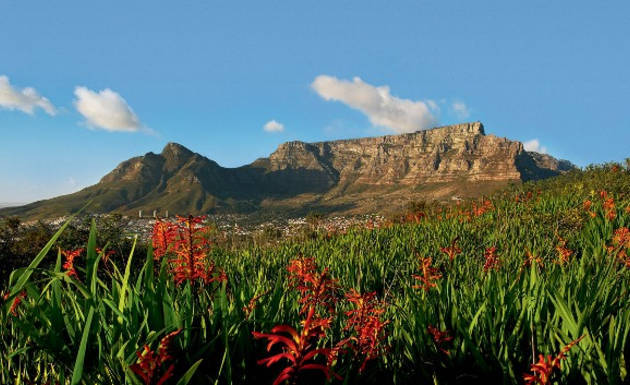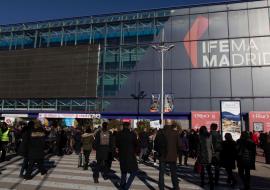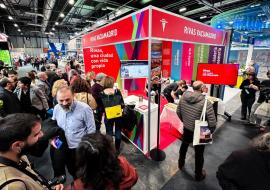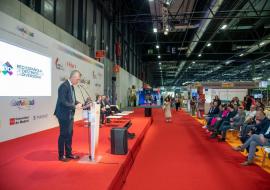Sustainable Destinations Increase their Value in the Face of FITUR

Sustainable destinations have considerably increased their value among the more than 1.2 billion international tourists who traveled worldwide in 2016, as will be established at FITUR, the International Tourism Trade Fair organized by IFEMA which is due to be staged from 18 to 22 January at Feria de Madrid.
In the first nine months of the year alone, a total of 956 million tourists traveled around the planet, according to the World Tourism Organization’s latest Barometer.
The figure represents a 4% increase over the same period of the previous year and confirms that tourism is one of the most resilient and fastest-growing economic sectors, one that is contributing to recovering the economy and to creating new business niches.
The dynamization role of tourism worldwide, and especially in Spain, is endorsed by the forecasts that point to 1.8 billion travelers in the planet as a whole by 2030 and to closing 2016 in our country with more than 74 million foreign travelers, says Luis Gallego, Chairman of the FITUR Organizing Committee and CEO of Iberia.
In the first nine months of 2016, the Asia-Pacific region was at the forefront of tourist growth, with an increase of 9%. And many destinations registered double-digit increases, with Republic of Korea (+34%), Vietnam (+36%), Japan (+24%) and Sri Lanka (+15%) heading the list. In Europe, international arrivals increased by 2% between January and September 2016, and growth was solid in the majority of destinations. Meanwhile, international tourist arrivals in the Americas saw an increase of 4% during September.
In this context, Spanish tourism has consolidated its position in 2016 as the country’s principal driver of economic growth and jobs. According to the Border Survey of Tourist Movements (Frontur), in the first ten months of the year Spain received 67.5 million foreign tourists. And as Julián Alcolea, Vice President of the Spanish Association of Tourism Professionals, reminds us, forecasts point to breaking all records in 2016 as a whole. “Evolution is so positive that initially the Bank of Spain estimated the increase of tourism GDP to be 3.2%, when in reality it will be 4.4%”. In the international ranking, Spain occupies third place worldwide in tourist arrivals (68.1 million in 2015) and in tourist expenditure (67 billion euros).
The latest Exceltur report explains that the tourism industry’s socio-labor contribution is at record levels. September 2016 closed with 87,693 more Social Security affiliates thanks to the increase in activity and the lengthening of the season, the best employment record in the past two decades. Tourism continues to drive job creation at 2.3 points above the generation rate of new jobs induced by the rest of Spain’s economic activities.
And the gap between its job creation capacity and that of the other major personnel-intensive sectors in the Spanish economy continues to grow. The increase of 5.6% in Social Security affiliates from tourism branches stands far above that of other key sectors such as construction and retail.
The UNWTO has designated FITUR 2017 as the occasion for the kick-off celebrations of the International Year of Sustainable Tourism for Development declared by the United Nations Organization and channeled through the Madrid-based World Tourism Organization.
The lines of action to be undertaken by the UNWTO for the International Year have the goal of boosting tourism’s contribution in terms of inclusive and sustainable economic growth; social inclusion, employment and poverty reduction; efficient use of resources, environmental protection and fight against climate change; cultural values, diversity and heritage; and mutual understanding, peace and security.
An international survey conducted by Booking, the hotel booking portal, confirms that between 2014 and 2015 international demand for more sustainable destinations increased fivefold. And in a professional meeting held in Málaga, international tour operators showed the results of a survey confirming that in 83% of cases, tourists are prepared to pay more in a 100-room hotel rated as sustainable, and that they quantify it at between one and five extra dollars per person/night in 30% of cases and between 10 and 25 dollars in 12% of cases.
In the sphere of accessibility, governments and operators from around the world are joining forces to facilitate tourism for the billion people on the planet who suffer from some type of disability. Accessibility has become a prime concern but also a business opportunity. The accessible tourism market accounts for around 27% of total population and 12% of the tourism market, according to a study by the European Union, “Economic Impact and Travel Patterns of Accessible Tourism in Europe”. These figures take into account the high percentage of older travelers (since people aged 60 years and older will account for 22% of the world population by 2050), people with disabilities and families with small children.
In environmental sustainability there is still some way to go in the field of tourism. It should be taken into account, for example, that energy accounts for between 4% and 25% of a hotel establishment’s running costs and that these could be substantially reduced by implementing efficiency measures, according to a study by the PwC consultancy and the Spanish Energy Efficiency Technology Platform (PTE-EE). In addition to the direct benefits for the hotel sector, developing such efficiency solutions would generate an industry that would contribute 860 million euros to the gross domestic product and nearly 5,000 jobs annually. This would mean savings in primary energy of 420 ktoe (kilotons of oil equivalent), leading to environmental improvement (savings of 835 ktCO2) and to gains in the Spanish balance of payments.
The Instituto Tecnológico Hotelero, ITH, recommends that ambient temperatures in a hotel should be kept within the comfort range to prevent added costs, since every degree of extra temperature represents around 7% more in consumption. They also explain that the use of efficient boilers can lead to savings of up to 20% in energy.
Specialization is making headway in tourism and is very much present at FITUR through different specialized sections –FITUR SHOPPING, FITUR HEALTH, FITUR GAY (LGBT), FITURTECH and others–, plus a broad and varied exhibitors offering. It could not be otherwise seeing the growing importance that the various segments are acquiring in the market.
In shopping tourism Spain is the seventh international destination, as brought to light by the “Shopping Tourism & Economy Summit” recently staged in Madrid. The Secretary of State for Trade, María Luisa Poncela, has emphasized the need to undertake reforms to drive forward this type of tourism in our country and, especially, to attract Chinese tourists, who made the highest average expenditure in 2015.
40% of tourists who travel abroad for leisure includes shopping among their activities, according to a Turespaña report. And Madrid and Barcelona are among the 10 most attractive cities for this, according to a study by The Globe Shopper Index. Tourists from outside the European Union spend 515 euros on average on this activity, according to the Secretary of State for Tourism, Matilde Asían. And in this field the markets with the greatest weight and potential for Spain are Russia and the USA, Asian countries (particularly China, Japan and South-East Asian countries) and Latin American countries (especially Mexico, Colombia and Argentina).
Health tourism is also on the rise. This is a worldwide market that is rapidly growing at an average annual rate of 20% in both number of patients and in the business volume it generates. Visitors who travel for health-related reasons spend up to eight times more than a conventional tourist, said the Managing Director of SpainCares, Mónica Figuerola, at the Hotel Congress recently organized in Salamanca by the Spanish Confederation of Hotels and Tourist Accommodation, CEHAT. Furthermore, in most cases such visitors come accompanied and their stays are longer. Countries such as Spain and Argentina –the 2017 FITUR partner– boast a comprehensive and attractive offer in health tourism.
LGBT tourism is also enjoying constant growth all over the world. Further proof of this are the more than 3 million people and associations from around the planet who will come together in 2017 in Madrid to celebrate worldwide LGBT Pride, the central event of the Madrid WorldPride due to be held in the center of the capital. WorldPride Madrid 2017 will be the great world festival of LGBT Pride, celebrating, debating and displaying diversity. An event that will be widely supported at FITUR GAY (LGBT).
Gastronomic tourism, one of the main features of numerous destinations and operators present at FITUR, continues to gain devotees. 15% of tourists who visited Spain in 2015 were mainly motivated by its food. And according to Rafael Ansón, the Chairman of the Royal Academy of Gastronomy, gastronomic tourism produced the highest levels of satisfaction in the 68 million visitors received this year by our country, together with transportation and infrastructures.
Wine tourism has become an important niche market. In 2015 this speciality generated in Spain a business volume of nearly 50 million euros, 15% more than the previous year; it boasts more than 2 million visitors. This segment will also be very much present at the Event organized by IFEMA.
Cruise tourism also continues on the rise. In 2015, 466,000 Spanish tourists embarked on a cruise, a more than 3% rise over 2014 and situating our country as the fifth most important source country in Europe, together with Germany, Great Britain and Ireland, Italy and France. The Mediterranean is the principal destination for the Spanish market, concentrating nearly 75% of passengers. We also observe important growth in cruises around Northern Europe and the Caribbean, reflecting a greater interest in seeing new destinations and discovering more quality holiday options.
Business travel constitutes a crucial segment for tourism, one that has great potential and requires new proposals. For example, 55% of Spanish companies has yet to define and draft a security policy for their corporate trips according to a study by GEBTA Spain conducted with the collaboration of Aon and Healix. The study concludes that more than ever we need “corporations to establish clear travel policies adapted to today’s scenarios in terms of security and assistance given the dynamic nature and high levels of internationalization of Spanish enterprise and a more unstable global context”.
Cultural tourism has culture as the central reason for most trips. 40% of international tourist arrivals in the world in 2015 was essentially driven by cultural motivations, a figure that will continue to rise in the next few years. This is the estimation made by the World Tourism Organization (UNWTO) in its report on Synergies between Tourism and Culture. In fact, tourism plays an important role in the protection and promotion of the material and intangible heritage.
Leisure and holidays account for a little over half of total international travel (53% or 632 million). Around 14% of tourists told the authors of a study conducted for the UNWTO that they travel for business or for professional reasons, while 27% say they travelled for other reasons such as visiting friends and relatives, religious reasons or pilgrimages, health treatments, etc.
Adventure tourism has been gaining devotees in recent years and worldwide turnover has exploded, up to 263 billion dollars annually according to calculations made by the Adventure Travel Trade Association, ATTA, a body representing more than 300 specialized tourism companies from 69 countries.
Young people are increasingly on the go, which means that tourism should take into account the demands of these travelers, who represent a total of 270 million people and who demand new products and permanent connectivity. This is one of the principal conclusions drawn at the 5th Global Summit on City Tourism recently staged in Luxor (Egypt), which attracted 400 experts from 40 countries to debate on the topic of “Cities: Local Culture for Global Travelers”.
With a special connection with these young people, technology and digitisation constitute major trends in today’s tourism. Furthermore, 90% of Spanish tourism managers says that digitization will be the most important transformation process in the next 10 years, as brought to light at the Smart Destination Congress Energy & Sustainable Tourism held in Palma de Mallorca.
Technology is also very much present in the tourism business through e-commerce. The products that continue to lead the online business are transportation tickets, the purchase of tickets for spectacles, the acquisition of clothing, complements and sports items, and accommodation and tourist package bookings (39.8%). This is the conclusion drawn from the data of the Global B2C E-commerce Report 2015 issued by the National Observatory of Telecommunications and the Information Society (ONTSI), which reports to the Ministry of Energy, Tourism and Digital Agenda.
All tourism industry operators will be present at FITUR. Prominent among them are travel agencies, which have overcome the crisis, says Rafael Gallego, chairman of the Spanish Confederation of Travel Agents, CEAV. Proof of this is that 50% of the 67.5 million foreign tourists who came to Spain in the first ten months of 2016 did so through Spanish travel agencies, though there are destinations such as the Canaries, Balearics and some parts of the Costa del Sol where intermediation was as high as 85%. The sector has also recovered 6,500 jobs and has increased the opening of new offices by 2%.
The hotel and restaurant industry has also emerged from the crisis and has started to show a solid recovery. Turnover in the Spanish hotel industry will reach 14.2 billion euros in 2016, 7% more than in the previous year. This progress has been assisted by the arrival of tourists and a favorable economic context, together with the instability of alternative destinations, according to the conclusions of the Informa D&B DBK Sectoral Observatory. The restaurant industry has not been left behind either, as in the first nine months of 2016 services in food and beverages increased sales by 6.5%.
Means of transport are fundamental in travel, whether international or national. In 2015, a little over half of total travelers who stayed overnight in the world arrived at their destination by air (54%), while the rest travelled by surface transport (46%), either road (39%), train (2%) or boat (5%). Airplanes are a growing means of transport also among tourists arriving in Spain. In the first nine months of 2016, visitors using this means of transport increased by 11.2% compared to the same period last year. For its part, in 2016 the vehicle rental industry will invoice 4% more in 2016 than in the preceding year, confirming the industry’s recovery after the economic crisis of the past few years.
Present at the FITUR trade fair will be the principal national and international destinations. According to UNWTO forecasts, in 2016 international arrivals worldwide will have grown at a sustained rate of between 3.5% and 4.5%. By regions, the forecast for Asia Pacific and the Americas was that they would lead growth (both of them between +4% and +5%), followed by Europe (between +3.5% and +4.5%). Estimates for Africa and the Middle East (both of them between +2% and +5%) were positive, although with a greater degree of uncertainty and volatility.
The first four positions in the 2015 ranking by international arrivals and by revenue are occupied by the same countries though in a different order. United States obtained the highest tourism revenue (205 billion dollars) and was the second destination in international arrivals (78 million). China is second in revenue, with 114 billion, and fourth by arrivals, with 57 million.
Spain ranks in third both by revenue (57 billion dollars) and by arrivals (68 million). And France is fourth by revenue, with 46 billion, but the first in arrivals, with 84 million tourists. United Kingdom is fifth by revenue and eighth by arrivals; Thailand sixth in revenue and eleventh in arrivals; Italy fifth in arrivals and seventh in revenue; Germany eighth in revenue and seventh in arrivals; Turkey sixth in arrivals and twelfth in revenue; Mexico ninth in arrivals and sixteenth in revenue; and the Russian Federation tenth in arrivals and 34th in revenue.
Most of the world’s major source countries have registered an increase in international tourist expenditure in 2016 (between the first three and nine months), according to the UNWTO’s latest Barometer. Of the first five, China, the largest in the world, continues to drive demand, with a double-digit increase in expenditure (+19%). United States also registered good results (+9%), from which many destinations in the Americas and other regions benefited. Germany registered an increase of 5% in expenditure, United Kingdom 10% and France 3%.
In the rest of the countries in the top ten list, tourist expenditure enjoyed considerable growth in Australia and the Republic of Korea (both +9%), and moderate growth in Italy (+3%). A further eight markets registered two-digit growth: Egypt (+38%), Argentina (+27%), Spain (+19%), India (+16%), Thailand (+15%), Ukraine (+15%), Ireland (+12%) and Norway (+11%).
International tourist arrivals in Europe increased by 5% in 2015 to a total of 608 million, a little over half the world total (51%). In Northern Europe, international arrivals increased by 7%, with outstanding results in the majority of destinations. In Iceland, they increased by 29% and Ireland and Sweden also saw two-digit growth rates. The largest destination in the sub-region, United Kingdom, registered 6% growth.
Central and Eastern Europe (+5%) returned to growth in 2015 after a decline in 2014. Tajikistan (+94%) virtually doubled the number of international arrivals in 2015, though starting from a modest base. Hungary (+18%), Romania, Slovakia (+17% in both cases) and Latvia (+10%) also registered two-digit growth rates. The Russian Federation, the largest destination in the sub-region, registered a 5% increase in visitor numbers, favored by a cheaper rouble. The Czech Republic and Poland grew by 5% in both cases. International arrivals in Southern and Mediterranean Europe increased by 5%.
Spain, the principal destination in the sub-region and the second largest in Europe, showed 5% growth and obtained a record 68 million international arrivals. Other consolidated destinations such as Andorra (+13%), Slovenia (+12%), Portugal (+10%), Croatia, Cyprus (+9% in both cases), Greece (+7%) and Malta (+6%) also registered good results. Italy received 4% more visitors after hosting the Milan Expo 2015. And emerging destinations such as Albania, Bosnia Herzegovina, Macedonia, Montenegro and Serbia showed higher-than-10% growth rates.
Growth was more moderate in Western Europe (+3%). In France (+1%), the world’s principal tourist destination, and in Belgium (+2%), the Paris terrorist attacks and subsequent “shutdown” of Brussels had an adverse impact on the results of the year as a whole. In contrast, the Netherlands (+8%), Germany and Austria (both +6%) saw significant increases. And in Switzerland arrivals increased by 2%.
The principal South-East Asia destination, Thailand (+20%), experienced a strong recovery in 2015, with a further 5 million international tourists. In Myanmar (+52%) arrivals also shot up last year, but from a modest base. Laos (+12%), Philippines (+11%) and Indonesia (+10%) also enjoyed two-digit growth rates. Cambodia received 6% more arrivals, while Singapore (+2%) and Vietnam (+1%) obtained more modest results.
Oceania saw solid growth of 7% in arrivals in 2015, driven by the sub-region’s principal destinations: New Zealand (+10%) and Australia (+8%). In North-East Asia (+4%), Japan registered exceptional growth of 47%, receiving a further 6 million international tourists to reach a total of 20 million. Taiwan (province of China) registered 5% more arrivals in 2015, and the largest Asian destination, China, gained 2%. International arrivals in Southern Asia increased by 4%, thanks above all to the sub-region’s principal destination, India (+5%).
North America, which accounts for two thirds of total arrivals in the Americas, received 6% more international arrivals. Mexico and Canada (both +9%) enjoyed important growth driven by US demand. Growth was more modest in the United States itself (+3%) owing to a stronger dollar, which made this destination more expensive for almost all of its markets. In the Caribbean (+7%), growth was driven by Cuba (+18%), Aruba (+14%), Barbados (+14%), Haiti (+11%), Dominican Republic and Puerto Rico (+9% in both cases).
In Central America, international arrivals in 2015 increased by 7% to exceed 10 million for the first time. Panama headed growth with an increase of 21%, Belize received 6% more arrivals, Costa Rica and Honduras 5% more, El Salvador and Nicaragua 4% more, and Guatemala 1%. International arrivals in South America grew by 6%, with Paraguay standing out by almost doubling the number; and Chile and Colombia showing two-digit growth.
Other countries such as Peru, Uruguay, Brazil and Argentina continued to work on consolidating their principal tourist strengths and attractions. Argentina, the partner of FITUR 2017, will take the opportunity of its presence at FITUR to achieve its goal of reaching 9 million international tourists by 2019. Undoubtedly contributing to this will be the Spanish market, the most important in Europe for Argentine incoming tourism. During 2015 more than 120,000 Spanish tourists arrived in Argentina. For its part, Spain received 405,575 Argentine visitors.
Spain continues to break records. Catalonia was the region which received the most international tourists in the first 10 months of 2016, with more than 16 million and an increase of 4.2% compared to the same period in 2015. Furthermore, this territory concentrated 22.4% of the 68.929 billion euros which foreign tourists spent in our country between January and October 2016, according to data from the National Statistics Institute, INE.
In tourist arrivals between January and October of this year, it was followed by the Balearic Islands (with 12.8 million and 11.9% growth) and Canaries (with 10.9 million and an increase of 13.6%). The Canaries are also experiencing growing demand in cruises, which led the archipelago’s ports to register a record year in 2015, having doubled passenger numbers in 10 years and receiving for the first time more than two million cruise passengers, an increase of 14.6% over the previous year.
The Madrid Region received in the first 10 months of 2016 a total of 4.8 million tourists, 11.8% more than in the same period in 2015. Tourists from America (not counting the United States) accounted for 20% of all those who came to this region.
Thanks to international tourism, 67% of Spanish tourism companies has increased sales and 51.4% has improved results, according to the quarterly Exceltur survey presented in October. Prominent among the destinations that most benefited last summer are Canaries, Balearics and Andalusia, where the income of tourism companies increased by more than 10%, as well as Asturias, Cantabria and the Basque Country.














